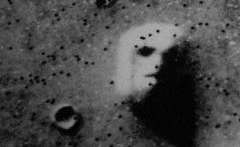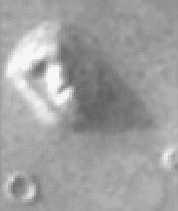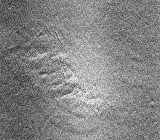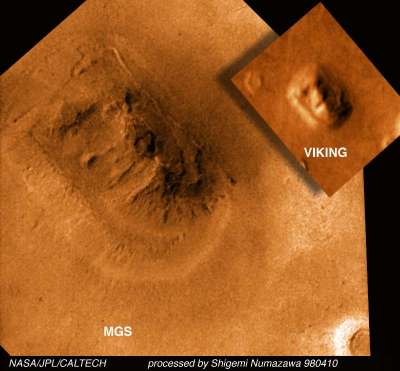In 1976, NASA had sent the Viking I probe to Mars to take photographs of the surface. Unknown to them, they would be taking a picture of something that would cause controversy for years to come. A few short years after the photos were taken, it was discovered there was a "Face" on Mars as well as a complex of sites that looked like pyramids.
The original images where of poor quality but tantalizing. Not only was there a face-shaped mountain but south of that land form were structures resembling pyramids and other large buildings.
The following is the close-up photo of the Face on Mars taken in 1976.
Below: The "Face" as photographed by Viking I in July 1976.

|
Below: The "face" after contrast enhancements and removal of photographic artefacts.

|
Below: The "face" as a 3D computerized model by Dr. Carlotto who is convinced that the face is of an artificial nature.

|
Below: The "face" as computer generated 3D animation. The greyish parts are the parts not visible on the Viking I photographs.

|
The "face" on Mars is located in the Cydonia Mensae region at roughly 40.9 degrees North latitude and 9.45 degrees West longitude.
As many as 18 images of the region were taken by the Viking 1 and 2 orbiters, but only seven have resolutions better than 250 m/pixel. The other 11 images have resolutions worse than 550 m/pixel and are virtually useless for studying the feature. Of the seven "good" images, the lighting and time at which two pairs of images were taken are so close as to reduce the number to five usable, distinct images. All five of these can be seen at the NSSDC Photo Gallery in raw and processed forms as JPEGS. They are also available as TIFF files in the raw form only on the NSSDC Photo Gallery FTP site for Mars images. Finally, they are available in PDS image format on the NSSDC's FTP site for CD-ROMs.
Later, Russian probes also photographed the "face" since, and we can see the same face-like features on an impressive set of different pictures from different angles and different lighting conditions now.
In late March of 1998, after much pressure from the public, from some ufologists and some scientists, NASA agreed to take new photos of the Cydonia Region and the "Face". A photo was taken on April 5th, 1998 by the Mars Global Surveyor (MGS) probe and was given to the newsmedia was the following photograph.
Quickly, scientists looked at the pictured and very soon saw in it the proof that the face on Mars is just a pile of rocks. Let's have a closer look.
First we go back to the source: the new raw image of the face, before any manipulation, ad NASA published it on its various official web sites:

|
Above: Yes indeed, this is the face as photographed by MGS, directly extracted from the "raw" file of Mars Global Surveyor! This is a very poor image, specially when compared to the older Viking photographs. This is the base used to draw a conclusion.

|
Of course this image has been enhanced and treated a lot to improve its contrast, which gives us again a very disappointing picture. Moreover, as you might have guessed, no picture whatsoever has been taken of the other features of the Cydonia Mensae region, a pity since ufologists and interested scientist are more puzzled by the nearby "pyramids" and other features than by the "face" itself.
Here you can get a copy of the whole raw picture as provided by NASA. Careful, this is a 1.6 MB jpg file.

|
Finally, after much rework and enhancements on this original picture, some scientists managed to provide striking evidences that the face is natural, nothing more than some rocks and a shadowplay.
Due to the media, we were all convinced that it has been proven that the face is natural. On the contrary, NASA does not say anything like this. They simply make the statement that there is no official NASA statement on the nature of the face.
They just mention that most scientists dismiss the face though no sufficient data exist.
At no time and at no place NASA ever made the same statement!
Here is the official answer from NASA on the case of the face on Mars:
"NASA has no official opinion on what the so-called "face" on Mars is. Most planetary scientists agree that, although there is insufficient data to make a definitive analysis of the feature, it is highly unlikely to be anything other than a combination of a natural feature and unusual lighting conditions."
The media, and the media alone, completely dismissed the Face. NASA did not.
Though it was legitimate to take an interest in it with the first pictures, with the better MGS picture the "Face" really seems to be just a natural feature vaguely looking like a face. I found no good evidence it is not.